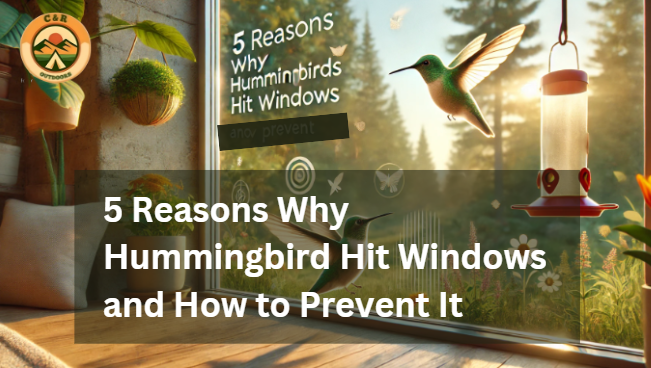There’s always a heart-stopping moment when hummingbirds hit windows. While it’s a startling experience for both the bird and us, you might be wondering why and how these lovely creatures ar unble to forsee a barrier before them.
The truth is windows made of glass reflect surrounding as trees, sky and the environment, tricking these birds into flying right into it. There are ways to help prevent it from happening again.
So to keep your yard a safe haven in order to prevent these accidents from recurring, you will need to understand these the top reasons why hummingbirds hit windows and offer practical, humane ways to prevent these accidents from recurring.
Why Hummingbirds Hit Windows

Hummingbirds, known for their fast flight patterns and sharp instincts, is quiet unbelieveable to withness such accidents, especially for not miss an obstacle in their path.
The fact is windows pose a unique challenge to humming birds, often becoming invisible barriers to these tiny fliers.
Due transparency and reflections in glass windows, it becames difficult for hummingbirds to distinguish a solid surface from what appears to be open sky or foliage.
The main reasons hummingbirds hit windows all points to it’s own instinct, natural behaviors, and a bit of optical trickery that confuses even the most agile creatures.
Types of Hummingbirds Prone to Window Collisions

Hummingbirds are best known for their agile flight and ability to hover in mid-air. Unfortunately, these unique flying capabilities make them more susceptible to window collisions due to window reflections mimicking their surrounding.
While most hummingbird species can potentially collide with windows, some are more prone than others.
For example, the Ruby-throated Hummingbird is commonly involved in window strikes due to its migratory nature and widespread distribution across North America.
5 Key Reasons Behind Hummingbird Collisions

1. Reflective Windows and Misleading Surroundings
Windows can mirror the outdoors due to their reflective feature, hence, reflecting trees, sky, or even nearby plants. To a hummingbird, this looks like more natural space to fly into rather than a solid barrier to crash into.
The clearer and more reflective your windows are, the more likely a bird will mistake them for open natural spaces for bird activities.
2. Attraction to Indoor Plants Seen Through Glass
For homeowners who love some outdoor and indoor plants may be posing more risks to hummingbirds. Sometimes, an indoor plant placed near a window can seem like the perfect decor and perch for a hummingbird.
Little did you know you are setting accidental traps unknowingly as they may fly straight toward it, not realizing there’s glass in between. This is especially common when attractive colorful plants or flowers are placed near the window, making it seem like a part of the outdoors.
3. Light Angles at Different Times of Day
The sun’s rotation throughout the day affects the angle of light hitting your windows changes. Certain lighting conditions, especially bright midday sun, can increase reflections, creating an even stronger illusion to hummingbirds of more sky or open envirnomental space for the birds.
4. Nesting Season Behavior
Hummingbirds are very active especially during the nesting season which makes them fly faster, chase each other, and spend more time foraging. This extra activity makes them more susceptible to window collisions in your yard.
5. Mistaken Perception of Open Space
Birds, including hummingbirds, often mistake large, clear windows as paths they can travel through. If you have windows on both sides of your house, birds might see a clear path and believe they can fly straight through—until they hit the glass.
How to Prevent Hummingbirds from Hitting Windows

Now that you know the 5 top reasons why a hummingbird hit windows, it will interest you to know that there are effective ways to make your windows safer for hummingbirds!
With a few adjustments, you can enable them spot the glass easily and avoid accidental collisions. Here are some tips to get started:
1. Install Window Decals or Bird-Safe Glass

Window decors or stickers strategically placed on the outside of your windows can break up reflections and alert birds to the presence of glass easily.
Look for specific decals made for bird safety, as they’re often designed to be highly visible to birds vision but subtle for human viewers.
2. Use Window Screens or Netting
Screen installations or netting over your windows creates a soft barrier that prevents direct birds collisions. If a hummingbird flies toward the glass, the screen can absorb the impact, reducing the risk of injury caused to the bird.
3. Reposition Feeders and Plants to Minimize Lure
Consider moving bird feeders a few feet away or directly next to the window, If you keep close to your windows. When feeders are too close birds are more likely to notice the glass and avoid hitting it, while feeders that are several feet away prevent them from approaching windows altogether.
4. Add External Decorations to Break Up Reflections
Hanging external decorations, like wind chimes or small mobiles, can help break up window reflections. These moving decorations add extra visual cues for birds to recognize the glass as a barrier.
5. Adjust Lighting to Reduce Glare and Illusions
Close curtains or blinds when direct sunlight hits your windows. Reducing indoor lighting can also prevent reflections helping to keep your windows less deceptive to birds.
What to Do if a Hummingbird Hits Your Window

Despite our best efforts, accidents are inevitable from our lives,as a hummingbird might still collide with a window. Now here’s what to do if that happens:
- Check the Bird for Injuries
If the bird appears stunned, it’s best to leave it alone for a few minutes to see if it recovers on its own. However, if it’s lying still or appears injured, carefully place it in a small box lined with soft tissue to provide a quiet, safe environment. - Observe for Signs of Recovery
Keep the bird in a safe, quiet spot away from pets or loud noises. Check on it every few minutes, watching for signs of movement or wing flapping. - Release the Bird Safely
Once the hummingbird seems alert and active, take the box outside and open the lid, allowing it to fly away on its own. Avoid handling it too much, as this can add stress to an already disoriented bird.
Final Words
By following these simple yet effective tips, you can make your home a safe haven for these harmless hummingbirds, allowing you to enjoy their visits without worry about window collisions.
With a little awareness and a few preventative steps stated in this blogpost, we can protect these beautiful creatures from accidental collisions and continue to marvel at their magical presence in our yards.
By caring for the safety of hummingbirds and other wildlife, we contribute to the preservation of biodiversity and the delicate ecosystems they inhabit.
Next time you witness a hummingbird approaching your window, be reminded of your role as responsible custodians of nature and take action to protect these tiny birds.

